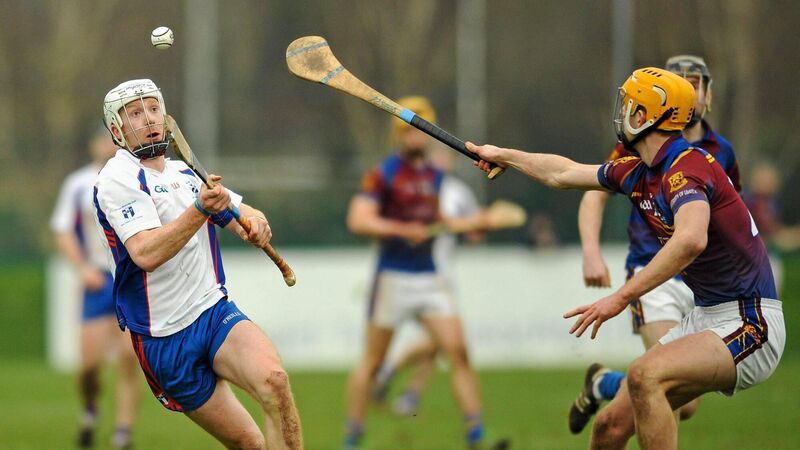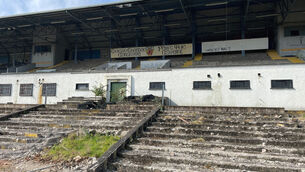Paul Rouse: Are the Fitzgibbon and Sigerson Cups still relevant in 2022?

Cian Lynch in action for Mary Immaculate College Limerick in the 2016 Fitzgibbon Cup final. Picture: Eóin Noonan / Sportsfile
“People who have never come in contact with the Fitzgibbon Cup can never quite understand the emotions it stirs in those who have. It is like the players become family. You eat, drink and sleep hurling for the duration,” wrote Nicky English in his autobiographical description of his time in UCC at the beginning of the 1980s.
At UCC, his playing career was reshaped by the coaching of the inimitable Fr Michael O’Brien. “I had never come across anyone like him before. We would train ferociously in the Mardyke where he barked his instructions like an army officer. . Those training sessions were Heaven for me as – physically – I started to become much stronger and I loved the drills he would have us perform.”
In the final of his first Fitzgibbon Cup competition, English played a starring role at centre forward. In the final, UCC defeated UCD in the final at Croke Park by seven points: “They were probably the better team but goalkeeper, Johnny Farrell, made some incredible saves. I played centre forward and got a goal which effectively put us clear. It was a big moment for me. In a matter of just six months, I had now won an All-Ireland minor and Fitzgibbon Cup medals. But, more than that, I had come from being a real bit-part player to being one of the mainstays of the team.
“Even though I had the excuse of injury, I was taken off in the All-Ireland minor final. Truth is, I knew Tipp would have won the game with or without me. No, make no mistake, the Fitzgibbon was what made me as a hurler.”
And in the course of his time in UCC, Nicky English won five Fitzgibbon Cup medals in a row, enjoyed memorable nights out and some fairly exceptional post-match banquets (“Suffice to say, the food tended to travel from table to table…”).
The GAA’s premier third-level competitions begin again next week. They were cancelled in 2021 due to Covid, but this year’s competitions are going ahead with 15 third-level institutions competing for a place in the Sigerson final to be staged at IT Carlow on the weekend of February 16/17.
The Fitzgibbon final will be played the following week, with 14 teams competing. There are also tiered competitions for smaller institutions.
For more than a century, the Fitzgibbon and Sigerson Cup competitions have been a singular part of the GAA’s calendar.
For two decades after its foundation in 1911, the Sigerson Cup was played almost always played in a league format between three teams: UCD, UCC and UCG. They were joined in 1933 by Queen’s University Belfast and the Sigerson became a straight knock-out competition. This remained the case until 1963 when Trinity entered. This meant adding a quarter-final to the tournament.
In the 1970s, NUI Maynooth and the University of Ulster were added, and then in the 1980s and 1990s, the number of third-level institutions taking part more than doubled as Jordanstown (later part of the University of Ulster), Thomond, NIHE Limerick (later University of Limerick), St Mary’s Belfast, and the Regional Technical Colleges (RTCs, which later became institutes of technology and then some again became technological universities) got involved.
The expansion of the Fitzgibbon Cup after its inception in 1912 followed a similar trajectory, with a huge increase over time in the number of colleges competing.
This broadening of involvement in both competitions is of course related to the transformation of access to third-level education in Ireland.
There are now around 250,000 students enrolled in third-level education in Ireland. This is a number which continues to advance every year. Indeed, it has increased by almost 20% in the past six years.
Take UCD, for example. There are now more than 33,000 students attending UCD. Back when the Sigerson and Fitzgibbon Cups started in 191-121, UCD had just over 500 students enrolled on its books. By the eve of World War Two, this figure was still only 2,500 across all its courses. It was only at the end of the 1960s that the number of students at UCD reached 10,000. The story of the transformation of Ireland lies within those numbers.
The extraordinary growth in numbers of students has been evident in every third-level institution for decade after decade through the late 20th century and into the 21st century.
For the great majority of the students in Irish third-level institutions, the Sigerson Cup has no meaning. Many will not even really know of its existence.
But for many top-quality Gaelic footballers who attend third-level, it is something that is a vital part of their college experience. It binds them into an institution and gives them a social circle that is extremely valuable.
And yet, there is no doubt that third-level competitions are under pressure given the on-going revision of the calendar and the move to a split season between club and county.
The fact that the academic year begins in September and ends in May places obvious constraints on when the competition can be played. After their inception, the competitions were usually played in February or in early March.
This was shifted in the 1920s to see the tournament played in November and December. An outbreak of foot-and-mouth disease in the autumn of 1967 saw the Sigerson and Fitzgibbon Cups revert to being played after Christmas. Usually, this meant February or early March.
The timing of the competition is essential to understanding its impact as an arena for developing players. The tradition of playing in the wet and cold is fundamental to the nature of the competition. It is true that pitches have greatly improved, but the physical and mental strength required to compete in the type of game that is played is unchanged.
This is particularly the case when it involves a weekend of semi-finals and finals played on successive days.
There are inter-county managers who absolutely believe in the merit of the Sigerson and Fitzgibbon Cups. They see it as a great opportunity for players to progress and improve in the company of outstanding players from other counties.
There are other managers who do not take that view. They, instead, see the competitions as an impediment to their own training programmes and their own planning for a new season.
There is something understandable in this. The fact this year’s competitions cut across the pre-season competitions and the early stages of the National League is a factor.
With Covid rampant and bringing repeated disruptions to the preparations of teams at many levels, the pressures on managers of all teams to prepare for the new split-season are significant.
That pre-season competitions are followed by seven league games in nine weeks (for footballers and almost as many for hurlers) and then the provincial championships starting almost immediately leaves no great space for manoeuvre.
And yet – apart altogether from the importance of Gaelic games having a significant place in university life – there are basic reasons why they should encourage players to play Fitzgibbon and Sigerson.
The first and most important reason is that the players love the games. It is a truly unique thing to get to share a dressing room and make a team with players from rival counties. When this is put beside the nature of the games that are played – hectic, physical, often open, sometimes reckless – you can see why they love it.
The second reason is that playing at third-level has a great habit of propelling players forward in their careers. This is true for players who arrive in college as relative unknowns. And it is also true for those who had impressive underage careers. For example, it is not difficult to believe that captaining Mary Immaculate College to win the Fitzgibbon in 2015/6 was a key step for Richie English. Declan Hannon was top-scorer and man of the match in that victory. The following year – when Mary Immaculate College won the competition again – Cian Lynch won man of the match in the final. Mary Immaculate benefitted from an influx of brilliant Limerick hurlers and those hurlers, in turn, benefitted from their time with Mary Immaculate.
There is one other aspect that matters – and it has nothing to do with winning or even about developing as a player; it is about the fun of it all and about seeking a new experience.
For three decades, Dave Billings ran the GAA club in UCD. He was fond of quoting a few lines of the poetry of William Wordsworth to remind everyone of what really mattered in a third-level GAA club:
And he expounded on this further when he wrote an article in 2011 to commemorate the centenary of the founding of the Sigerson Cup: “‘The Sigerson Cup is more about memories than medals. Long after student days are over the mention of the Sigerson Cup recaptures the days of our youth, of teammates who you would die for on the field and they for you. In these memories, we stay eternally young. Time moves on, of course, but in the mind it is not the grey-haired middle aged man that you see in front of you; rather it is the dashing, young athletic man in his prime, on the field of play.”








